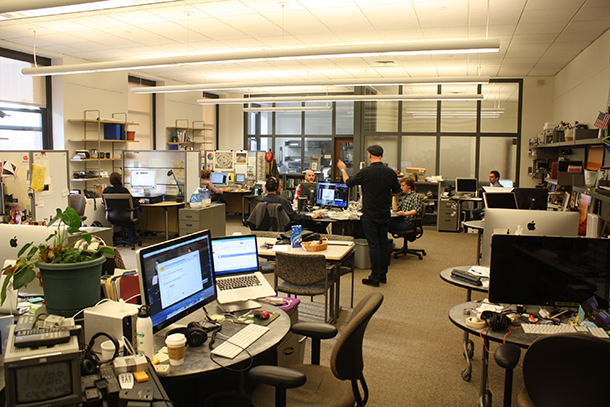CU Visit

Visit to Columbia University
My visit to Columbia University entailed meeting with Marc Raymond Senior Experience Designer at Teaching and Learning, Columbia University.

As the CTL’s Senior Experience Designer, Marc provides creative planning, direction, and implementation for educational technology projects and initiatives.
His work can be seen in the web, print, identity, and video design of numerous Columbia platforms, campaigns, events, and services. He has been an integral creative contributor to Columbia projects since 2001.
mraymond@columbia.edu
Mark took me for a tour around the Butler Library, the University’s main Library, it is also where most of Teaching and Learning is housed.
I asked Mark a few questions:
How is the department structured?
We are the Centre for Teaching and Learning - Leadership
How do you manage your study guides?
What is study guides? We don’t have study guides, the lecturer places most of their material on the LMS. Anything the students need to know about the subject is communicated through the LMS.
Do you focus only on Teaching & Learning or more on Tech support ?
Both, we but more teaching, we are a full stacks studio, so if we and build new apps or websites from the ground up.
What LMS do you use?
Courseworks Sakai.
More on Coursworks
A first step for many instructors who want to use technology in the classroom is to set up a course website to help manage course documents and activities. CourseWorks@Columbia, the University’s learning management system (LMS), offers instructors course sites to post readings, library reserves, and syllabi. A CourseWorks site is a good way to make course material accessible to students at any time — in many cases eliminating paper handouts. Instructors can easily revise course materials as the semester progresses or migrate the materials to a course in the future. CourseWorks also offers has tools for scheduling meetings, assignments and online testing, and student collaboration. In addition, some third-party tools, such as the BIgblueButton video conferencing tool and the Piazza discussion tool have been integrated with CourseWorks to provide a seamless learning experience for students.
Do you monitor the user experience on the LMS and how?
Teaching with CourseWorks
The Center for Teaching and Learning has partnered with the Teaching & Learning Applications group in Columbia University Information technology (CUIT) to introduce new educational technology tools. Fall 2015 through Spring 2016 we will be piloting audience response systems (ARS), video conferencing tools, and high-stakes online testing tools. All instructors are invited to participate. Our first pilot tools are:
Audience Response System (ARS): Turning Point
Video Conferencing Tools
BlueJeans
Zoom Video
newrow_
High-Stakes Online Testing Tool: DigiExam
We also have a director of assessment, his team looks at:
Teaching Strategy
Assessment
Accountability
Teaching assistance
and support
In what other ways do you give academic support?
http://ctl.columbia.edu/services/project-development/
CourseWorks Support
The CTL offers faculty and instructors many ways to get help with CourseWorks, a including searchable Knowledge Base and one-on-one consultations.
Online resources, CourseWorks help in the Knowledge Base
In person support.
Mediathread
Mediathread is an innovative new platform built by CCNMTL that supports collaborative multimedia analysis. Users of Mediathread are able to lift video, audio, and image items from a range of digital collections and then work with them in a course-specific website.
Instructors designate digital collections that contain source materials for a given course, and post analytic assignments in Mediathread. WIth the click of an easily installed browser bookmarklet, students can import items from these collections into Mediathread, where they then can then be annotated, organized, shared, and embedded into multimedia compositions.
Collections compatible with Mediathread include groups of videos, audio files, and/or images assembled for courses, multimedia databases licensed by Columbia University Libraries, and publicly available collections such as YouTube, Flickr, OpenVault, and Wikimedia Commons.
Teaching with Mediathread
Mediathread is used in numerous courses and departments across Columbia University. These real-life examples show how Mediathread can be used to enhance teaching and learning in three different areas: teacher education, social work, and film study.
Teaching Initiatives and Programs
Educational Technology &
Instructional Design
Administrative Support
Communications
Teaching Technologies
Products and Services
Online Publishing Initiatives
Software Development and
Experience Design
Media Production
Technology
Edblogs
EdBlogs provides a blog for any course offered at Columbia University upon the course instructor’s request. EdBlogs make it easy to share course content and create an online community using a blogging format.
Blogs use familiar, word-processor-style editing tools for adding and editing text and images, so it’s easy to create, update and revise posts. Take a look at the EdBlogs support page to learn more tips and techniques for managing an EdBlog.
EdBlogs are set up with a simple template that accommodates most course needs, including blogging, journal writing, or even a simple course web site. Instructors will also be able to choose an alternate template to suit specific course requirements. You may see examples of how Columbia faculty have used EdBlogs to enhance teaching and learning by visiting the faculty examples page.
Here are some examples of how Columbia faculty have used EdBlogs to enhance teaching and learning:
Wikispace
Columbia Wikispaces provides a wiki to every active registered course at Columbia University. A wiki is a collaborative tool that allows students to easily create, link, and modify one or more pages of course related materials. Wikis are collaborative in nature and facilitate community-building within a course.
Log into Wikispaces | Email Activate your course wiki.
Teaching with Wikispaces
Some common collaborative wiki projects include:
Collaboratively-authored creative pieces or reports.
Annotated bibliographies where students add summaries and critiques about course-related readings.
Manuals or glossaries of useful terms or concepts related to the course, or even a guide to a major course concept
Online repositories of course documents where instructors and students can post, comment or classify documents relevant to the course.
E-portfolios of student work.
Case Consortium
The Case Consortium @ Columbia includes a collection of over eighty multimedia case studies covering a range of topics in fields such as journalism, public health, and sustainable development. Most case studies are historically accurate, and were written based on original research by professionals in the field. Some have been translated into Spanish. The case study collection is enhanced with resources for faculty and students who wish to learn more about teaching and learning with case studies.
The case studies are available to the public for free as open educational resources. The Case Method encourages systems thinking and prepares students for the complexity of real life decisions that they will likely face during their careers. The heart of the Case Method is the “teaching” case study, so-called because it is used to facilitate classroom discussion. Most teaching cases are “decision forcing”—that is, the narrative stops at a critical turning point or decision point.
The case study initiative aims to develop students’ analytic, decision-making, management, and leadership skills by adding case-based learning to traditional instruction. Each case requires students to put themselves in the shoes of professionals to grapple with a wide range of issues. The cases are coupled with a teaching note, and most also include an epilogue. These cases can support a variety of pedagogies, and are flexible enough for faculty to develop unique strategies to support their teaching goals. For example, components of some case studies are revealed slowly, thus simulating the actual situation and the stressful decision points that unfold with it.
This rich collection of case studies was developed at the Columbia Journalism School in 2008. The Center for Teaching and Learning (CTL) now administers the new site, launched in 2015. The CTL also supports case-based learning by providing workshops to the University community on teaching with the Case Method.
What other software do you use?
Qualltrace for Research, data visualisation, secure data base, sms delivery
Columbia is a conservative university when it comes to new technology, we do not invest in something that is not tested, we use tools that are vetted and that endures. We progress steadily.
How do you support students with disabilities?
We have an office for disability that works closely with us for any technical needs they have. Our LMS also supports reading for the visually impaired.
What tools do you use when it comes to app and web design?
Django Projects, for quick prototyping and web apps.
We also use Mezzanine CMS with Django.
Wordpress sites
What process do you follow with your projects?
1. Strategy: user needs, site objectives
2. Scope: functional specifications, content requirements
3. Structure: interaction design, information architecture
4. Skeleton: information design, navigation design, interface design
5. Surface: visual design
§
